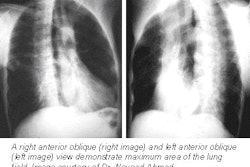The 426-bed Dallas Veterans Affairs Medical Center has a well-developed disaster recovery plan. Its requirements are somewhat different from those of nongovernmental hospitals, as all VAMC physicians and other staff are U.S. employees, and must follow the medical center’s standards. There are no off-site referring physicians.
The plan’s author, Ward M. Terry, MD, PACS medical director and system manager at Dallas VAMC, describes how data is saved and backed up at the institution:
- The PACS is housed in the radiology department within its own keyed room, inside the conventional film file room. Two servers offer short-term storage, optical jukeboxes, backup tape drive, switching HIS/RIS connections, and remote access (RAS) servers. There is independent air conditioning, a sprinkler system, TV surveillance, and generator power on demand.
- Images are transmitted automatically to an on-site backup server capable of storing 36 hours worth of image data, which is co-located with a diagnostic workbench in a limited-access clinical area away from the computer room. Thus, duplicate images are physically separated.
- At 5 p.m. every day, the day’s images and data are dumped onto optical disks. At 11 p.m. each night, the day’s work is backed up on tape, which goes to basement storage to be picked up weekly and transferred a secure, environmentally controlled site that is remote from the medical center campus.
- Contingency plans and disaster scenarios have been developed and documented in cooperation with an outside vendor, and include quadruple data redundancy. The status of each level is checked at least once daily. The ability to restore data from disaster tapes is tested at least yearly. When contingency plans need to be implemented, a member of the PACS team is on site to coordinate the effort.
Dallas VAMC has also developed PACS destruction and recovery scenarios:
- Total destruction of the computer room. In such an event, viewing workbenches would be pointed at the backup server for retrieval of recent (past six days) images. Off-site image data tapes would be used to reconstitute the entire archive on repaired or replaced servers and optical disks. Selected input modalities would be pointed at the backup server.
- Simultaneous failure of both PACS servers. Recent images would be retrieved as above. Input modalities would be pointed at the backup.
- Failure of the hospital’s 10-MB Ethernet network. All diagnostic workbenches in the radiology department would be made available for clinical viewing. Patient demographic data would be entered at modality keyboards.
- Failure of the decentralized hospital computer program (DHCP) with preservation of the hospital Ethernet. Patient demographic data would be entered at imaging modality keyboards with records kept of manually assigned case numbers.
- Electronic failure with switchover to generator power. Conventional images would be obtained in just two rooms. If the hospital Ethernet were preserved, plates would be processed in either of two rooms. Should the hospital network go down, a room is specified for plate processing. The diagnostic workbenches in just two rooms would be made available for clinical viewing.
AuntMinnie.com contributing writer
January 17, 2002
Related Reading
Disaster recovery case study #2: UCSF’s model for PACS recovery from off-site storage
Copyright © 2002 AuntMinnie.com



















